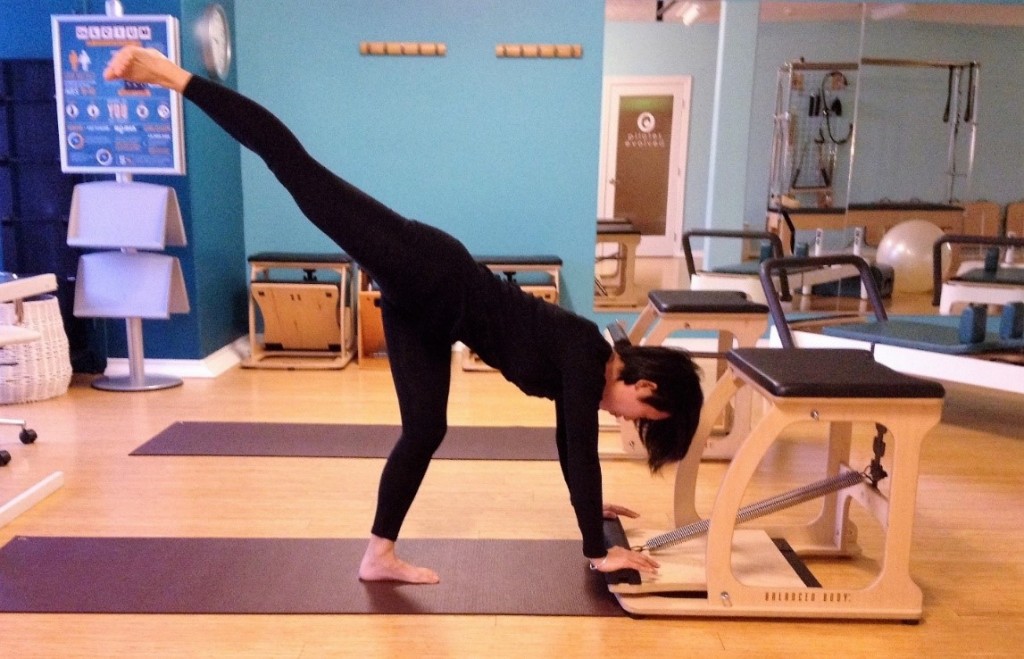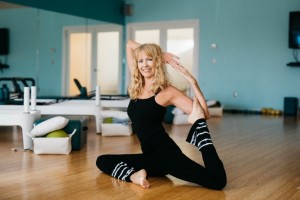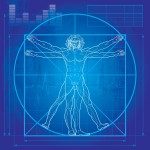Spatial Awareness Becomes Part of a Pilates Practitioner’s Literacy
Larkin Barnett B.A., M.A.
Four decades ago, my college dance professor, Eija Celli, was beating on a drum while encouraging us to take up as much space as possible leaping across the floor. It was fun to push movement boundaries and I was hooked! Eija danced with Martha Graham, Merce Cunningham and the students of the renowned spatial movement theorist, Rudolf Von Laban.
Dancers make the stage space come alive because it’s their canvas. We can contribute to a Pilates student’s experience through a systematic analysis of their bodies moving with clear spatial intent. The athletes we cross-train must maintain awareness of the athletic field and other players, while moving in multiple planes. The zone beyond the Pilates equipment environment helps connect the athlete to this broader spatial arena. This spatial perspective allows them to soar past competitors and have less overuse syndromes and injuries.
Our everyday moves in civic space have become confined gestures. The result is a severe lack of range of motion, poor posture, chronic tension, inefficient breathing, weak muscles, etc. In contrast, Pilates allows for expansive movements into space. Each move begins with core initiation from within the trunk, continues out to a limb orientation, and then returns to center. The reach-potential at the perimeter of the limbs extends the body territory beyond what is accessed in everyday activities. The quiet movements of Pilates reside within this total spatial awareness.
I believe Pilates cultivates a “sixth sense” called proprioception – an awareness of where the body is positioned in space, as well as the reach/space beyond its frame. Spatial processing generates awareness of our space-compass in geometric terms. You use this awareness in everyday activities such as gauging the time needed to cross the street in traffic.
Analysis of the spatial field around the student is a powerful teaching tool. When these ingredients become the focus of a Pilates practitioner’s literacy, it extends movement possibilities.
Elements of Space
- Directions in Space: Vertical / Horizontal / Sagittal
- Levels in Space: High / Medium / Low
- Pathways in Space: Straight/Curvy
The Elements of Space Lay the Ground Rules for Pilates Principles
You might ask, “don’t our students have enough to ‘think’ about already?” Pilates principles are present by enlisting the universal movement elements of space.
I ask my Pilates students to visualize moving with precision into a larger 3-D cube with an awareness of the entire room – front and back corners, ceiling and floor, and all four walls. Students define each movement orientation by picturing the body moving within this three-dimensional cube. You will suddenly see them take ownership of the vertical, horizontal, and sagittal planes and the high, medium and low levels of the cube! The student learns a new finely-tuned focused ability to carve through space helping them make continual adjustments in their balance. They’re able to “find” when they’re off center. All this awakens the inner unit (mind/body) and physicality connection. Space becomes something real to move through versus something intangible.
This implements the Pilates principle of oppositional lengthening: simultaneously “extending” the body in multiple directions cultivates muscular and spatial counter-tensions of their body within the cube. For example, the student looks like moving sculpture when the Pilates principle of the body moving as a unit combines with the 3-D cube. Movement becomes “art in motion” when the “constant awareness” between the body’s internal state of core muscular tension meets the space surrounding the body.
Accessing space through a razor-like concentration helps the student “recognize” kinetic forces. In everyday life, students are used to hauling the weight of their body around without awareness of gravity. Spatial awareness involves kinetics: the body moving in space with relationship to the forces of gravity, energy, and controlled momentum. The student gains kinesthetic confidence exploring teetering “off-center” movements into space, yet controlled from deep within center. They find the best place to find center is along the edges of the space. Reaching into space in new ways awakens and cultivates deep intrinsic muscles students could never feel before.
Spatial Awareness and Exploring Equipment Anatomy via Spring Tension
Students must maintain joint integrity as they trace spatial perimeters. Let’s consider how the springs provide feedback during supine leg circles with the feet in the straps on the Cadillac:
- Does the student’s body need to be closer to, or farther from, the spring bar to maintain proper resistance throughout the exercise?
- Are the springs lax at any point or do they start to quiver? Does the resistance need to be made lighter by lowering the cross bar? Are their muscles getting fatigued or stronger?
- Are the legs opening into space equally? Are the legs lining up at center with their spine, nose and navel?
- Is the student “standing” in the straps with balanced foot pressure – as if each foot centers on a “plus sign”? The weight should be equal on the toes, balls, arches, and heels throughout the circle.
- Cue to gently integrate the femur bones into the hip-joint capsule by contracting the core. You will notice how the pelvic bones become level and quiet. The legs move with efficient dissociation at the hip joint.
- Ask the student to listen for a continuous rhythmic, underwater sound of the springs.
The student’s total-body operates more cohesively when they focus on spatial margins AND springs. Movement flows along a space/spring/body-aligned continuum. When the student maintains a constant awareness of the genius of the Pilates springs, they slow down on the positive AND negative aspect of each movement. The springs seem to merge with the miracle of the body’s suspension system, enhancing neuro-muscular symmetry. Students interface with the springs by feeling their muscles move them out, as well as in. When the springs rest, the core doesn’t.
I ask my students to “move” the springs with their breath. During the positive: lengthen the duration of the exhalation, while focusing on the spring resistance through every millimeter of space. During the negative: allow the inhalation of air to expand the back surfaces of the body, while still encouraging spring resistance via inner core tension. Don’t let the springs have a life of their own by moving too fast using momentum or by just “riding the return” of the springs with little muscular tension.

Emphasis on total-body spatial explorations enhances functional movement improvements. For example, the back-spaces of the 3-D cube allow our structures to explore an ever-expanding relationship to self-space not used in daily life – except when we back out of the driveway. When a student extends their leg behind their body and the back foot is limp, it’s difficult to fire the hamstrings/glutes to feel the back-space. By flexing at the ankle, the full circumference of the leg and core muscles activate to fill up the entire cube.
The goal of Pilates is not to move into multiple levels, directions, and planes of space within a single exercise, but doing so builds new engrams or coordination patterns. After my students perform a set with incredibly focused spatial/spring intent, the result is what I refer to as the Pilates wellness quotient: the heated core, an elevated heart rate, rosy complexion, and airway clearing. Primarily, my clients feel they slow down when playing with space. Spatial awareness generates a variety of movement qualities along with the strength, relaxation, energy, balance, and joy – that is Pilates!
 Larkin Barnett, B.A., M.A. Dance, is a Polestar certified Pilates instructor with two specializations in Golf Pilates. Larkin is the author of six books and a Pilates DVD and companion manual. She has been a movement educator for over four decades including at seven universities and Canyon Ranch Spa where she taught celebrities and Olympic athletes. Pilates Method Alliance grants 60 PMA CEU’s for Pilates instructor training in her system.
Larkin Barnett, B.A., M.A. Dance, is a Polestar certified Pilates instructor with two specializations in Golf Pilates. Larkin is the author of six books and a Pilates DVD and companion manual. She has been a movement educator for over four decades including at seven universities and Canyon Ranch Spa where she taught celebrities and Olympic athletes. Pilates Method Alliance grants 60 PMA CEU’s for Pilates instructor training in her system.
Larkin teaches for Pilates on Tour with Dr. Gregory Loewen, pulmonary oncologist. She works with his respiratory patients, who attain remarkable clinical results using her Barnett Formula™. Pilates Style Magazine’s January, 2017 issue features her Formula. It provides a simple strategy for inwardly shaping core muscles into specific directions. Larkin’s books: “Practical Centering: Energize your Chakras for Relaxation, Vitality, and Health,” (Winner Nautilus Book Award), “Athletic Kinetics: Pilates and Performing Arts Aesthetic DVD & Companion Manual,” “Practical Pilates using Imagery,” (with Miami City Ballet), “Pilates and Calisthenics for Children,” “Creative Yoga for Children,” and “On a Lark! Creative Movement for Children.” Visit Larkin at www.larkinbarnett.com and her professional page, www.facebook.com/larkinbarnettpilates.

